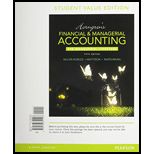
Horngren's Financial & Managerial Accounting, The Managerial Chapters, Student Value Edition (5th Edition)
5th Edition
ISBN: 9780133851496
Author: Tracie L. Miller-Nobles, Brenda L. Mattison, Ella Mae Matsumura
Publisher: PEARSON
expand_more
expand_more
format_list_bulleted
Question
Chapter 1, Problem 4QC
To determine
Business entity: A business organization which is created by one or more persons and governed by the state law is referred to as business entity.
To find: The type of business organization that is owned by single owner
Expert Solution & Answer
Want to see the full answer?
Check out a sample textbook solution
Students have asked these similar questions
Which is not an objective of internal controls?A. Safeguard assetsB. Improve profitsC. Ensure accurate recordsD. Promote operational efficiencyneed help
Which is not an objective of internal controls?A. Safeguard assetsB. Improve profitsC. Ensure accurate recordsD. Promote operational efficiencyno ai
Can you solve this general accounting problem using appropriate accounting principles?
Chapter 1 Solutions
Horngren's Financial & Managerial Accounting, The Managerial Chapters, Student Value Edition (5th Edition)
Ch. 1 - Prob. 1QCCh. 1 - Prob. 2QCCh. 1 - Prob. 3QCCh. 1 - Prob. 4QCCh. 1 - Prob. 5QCCh. 1 - Which of the following requires accounting...Ch. 1 - At the end of a recent year, Global Cleaning...Ch. 1 - Consider the overall effects on Global Cleaning...Ch. 1 - Assume that Global Cleaning Service performed...Ch. 1 - The balance sheet reports the a. financial...
Ch. 1 - Assume Global Cleaning Service had net income of...Ch. 1 - What is accounting?Ch. 1 - Prob. 2RQCh. 1 - Prob. 3RQCh. 1 - Prob. 4RQCh. 1 - Prob. 5RQCh. 1 - Prob. 6RQCh. 1 - Prob. 7RQCh. 1 - Prob. 8RQCh. 1 - Prob. 9RQCh. 1 - Which concept states that accounting information...Ch. 1 - Financial statements in the United States are...Ch. 1 - Prob. 12RQCh. 1 - Prob. 13RQCh. 1 - Prob. 14RQCh. 1 - Prob. 15RQCh. 1 - Prob. 16RQCh. 1 - List the four financial statements. Briefly...Ch. 1 - What is the calculation for return on assets...Ch. 1 - Identifying users of accounting information For...Ch. 1 - Prob. 1.2SECh. 1 - Prob. 1.3SECh. 1 - Prob. 1.4SECh. 1 - Applying accounting assumptions and principles...Ch. 1 - Using the accounting equation Kenmore Handyman...Ch. 1 - Using the accounting equation Joshs Overhead Doors...Ch. 1 - Identifying accounts Consider the following...Ch. 1 - Using the accounting equation to analyze...Ch. 1 - Using the accounting equation to analyze...Ch. 1 - Identifying accounts on the financial statements...Ch. 1 - Prob. 1.12SECh. 1 - Use the following injo17nation to answer Short...Ch. 1 - Prob. 1.14SECh. 1 - Prob. 1.15SECh. 1 - Calculating Return on Assets (ROA) Refined Water...Ch. 1 - Prob. 1.17ECh. 1 - Prob. 1.18ECh. 1 - Prob. 1.19ECh. 1 - Using the accounting equation Compute the missing...Ch. 1 - Using the accounting equation Green City Builders...Ch. 1 - Prob. 1.22ECh. 1 - Using the accounting equation During 2016,...Ch. 1 - Using the accounting equation The records of...Ch. 1 - Using the accounting equation to analyze...Ch. 1 - Using the accounting equation to analyze business...Ch. 1 - Using the accounting equation to analyze business...Ch. 1 - Prob. 1.28ECh. 1 - Using the accounting equation to analyze business...Ch. 1 - Preparing the financial statements Estella Osage...Ch. 1 - Use the following information to answer Exercises...Ch. 1 - Use the following information to answer Exercises...Ch. 1 - Use the following information to answer Exercises...Ch. 1 - Use the following information to answer Exercises...Ch. 1 - Use the following information to answer Exercises...Ch. 1 - Use the following information to answer Exercises...Ch. 1 - Preparing the statement of cash flows For each...Ch. 1 - Preparing the statement of cash flows Bean Town...Ch. 1 - Calculating return on assets (ROA) Alec Appliance...Ch. 1 - Using the accounting equation for transaction...Ch. 1 - Using the accounting equation for transaction...Ch. 1 - Preparing financial statements Presented here are...Ch. 1 - Preparing financial statements Click a Pix...Ch. 1 - Preparing financial statements The bookkeeper of...Ch. 1 - Prob. 1.45APCh. 1 - Using the accounting equation for transaction...Ch. 1 - Prob. 1.47BPCh. 1 - Using the accounting equation for transaction...Ch. 1 - Prob. 1.49BPCh. 1 - Prob. 1.50BPCh. 1 - Preparing financial statements The bookkeeper of...Ch. 1 - Using the accounting equation for transaction...Ch. 1 - Using the accounting equation for transaction...Ch. 1 - Using the accounting equation for transaction...Ch. 1 - Lets examine a case using Gregs Tunes and Sals...Ch. 1 - The tobacco companies have paid billions because...Ch. 1 - Prob. 1.1CTFCCh. 1 - This and similar cases in later chapters focus on...
Knowledge Booster
Similar questions
- Which is not an objective of internal controls?A. Safeguard assetsB. Improve profitsC. Ensure accurate recordsD. Promote operational efficiency no aiarrow_forwardPlease provide the accurate answer to this financial accounting problem using appropriate methods.arrow_forwardI am searching for the accurate solution to this financial accounting problem with the right approach.arrow_forward
- 20 Nelson and Murdock, a law firm, sells $8,000,000 of four-year, 8% bonds priced to yield 6.6%. The bonds are dated January 1, 2026, but due to some regulatory hurdles are not issued until March 1, 2026. Interest is payable on January 1 and July 1 each year. The bonds sell for $8,388,175 plus accrued interest. In mid-June, Nelson and Murdock earns an unusually large fee of $11,000,000 for one of its cases. They use part of the proceeds to buy back the bonds in the open market on July 1, 2026 after the interest payment has been made. Nelson and Murdock pays a total of $8,456,234 to reacquire the bonds and retires them. Required1. The issuance of the bonds—assume that Nelson and Murdock has adopted a policy of crediting interest expense for the accrued interest on the date of sale.2. Payment of interest and related amortization on July 1, 2026.3. Reacquisition and retirement of the bonds.arrow_forward13 Which of the following is correct about the difference between basic earnings per share (EPS) and diluted earnings per share? Question 13 options: Basic EPS uses comprehensive income in its calculation, whereas diluted EPS does not. Basic EPS is not a required disclosure, whereas diluted EPS is required disclosure. Basic EPS uses total common shares outstanding, whereas diluted EPS uses the weighted-average number of common shares. Basic EPS is not adjusted for the potential dilutive effects of complex financial structures, whereas diluted EPS is adjusted.arrow_forwardPlease explain the solution to this general accounting problem with accurate explanations.arrow_forward
- I need guidance with this financial accounting problem using the right financial principles.arrow_forwardGeneral Accounting Question Solutionarrow_forwardWhich is not an objective of internal controls?A. Safeguard assetsB. Improve profitsC. Ensure accurate recordsD. Promote operational efficiencyarrow_forward
arrow_back_ios
SEE MORE QUESTIONS
arrow_forward_ios
Recommended textbooks for you


